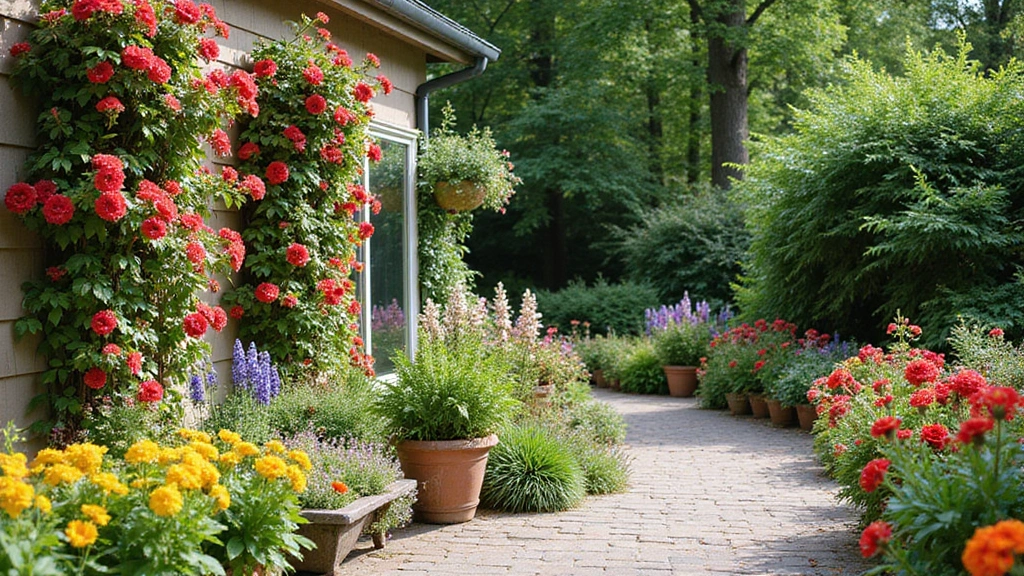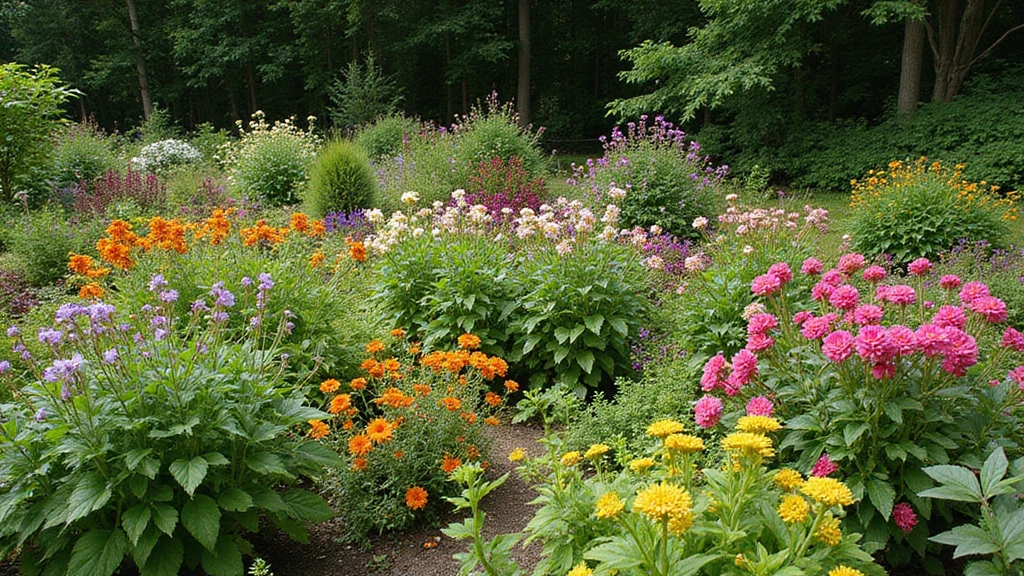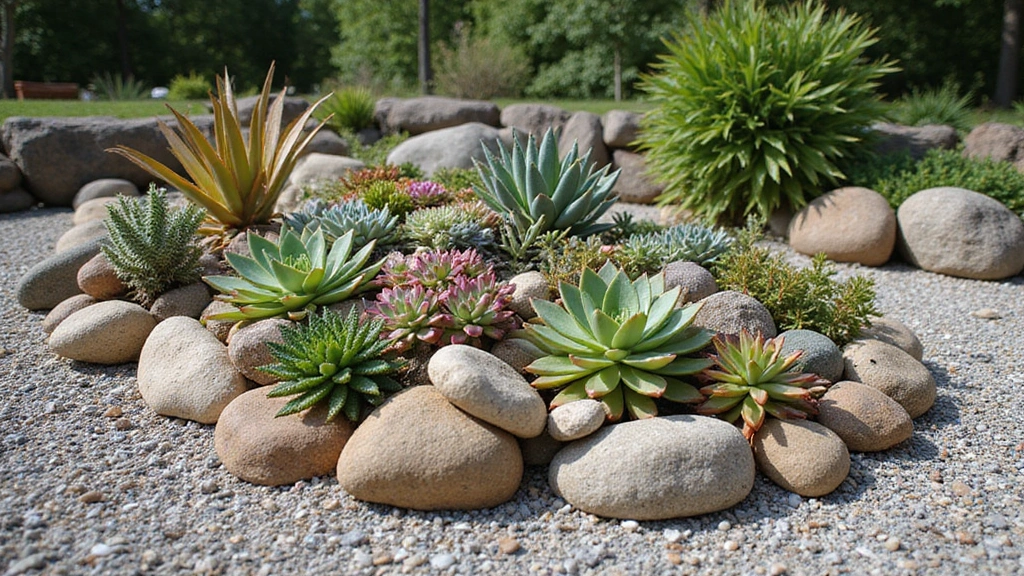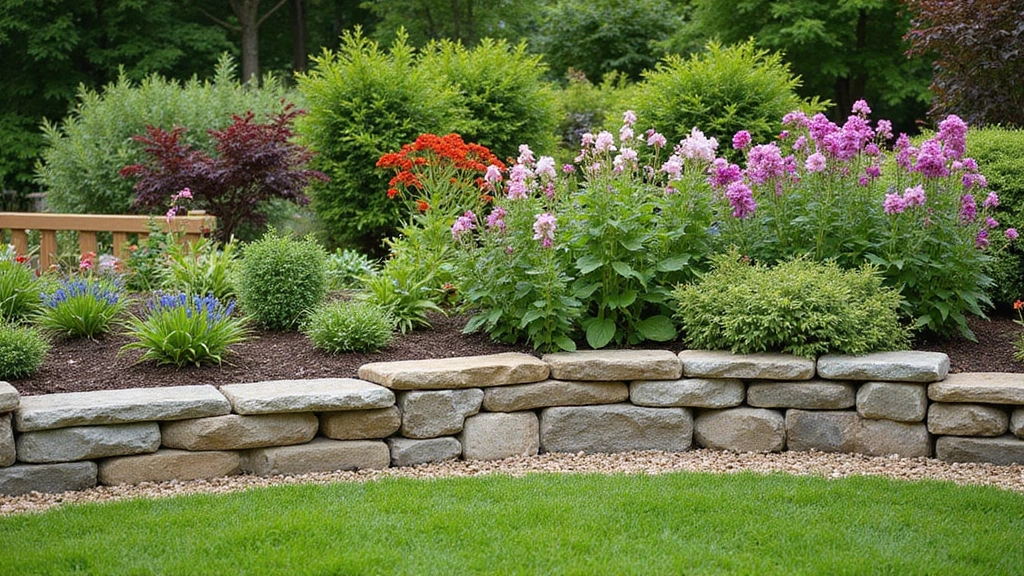Creating a stunning rock garden can transform your outdoor space into a serene escape, perfect for small areas and low-maintenance designs.
Imagine a landscape that harmonizes with nature, showcasing drought-tolerant plants and natural stones that blend effortlessly into the surroundings.
The beauty of rock garden landscaping lies in its simplicity and adaptability. With just a few thoughtful choices, your garden can reflect a natural look that requires minimal upkeep but provides maximum visual impact.
Let’s explore a collection of 29 tips to help you design a breathtaking rock garden that fits your space and style.
1. Choose the Right Location
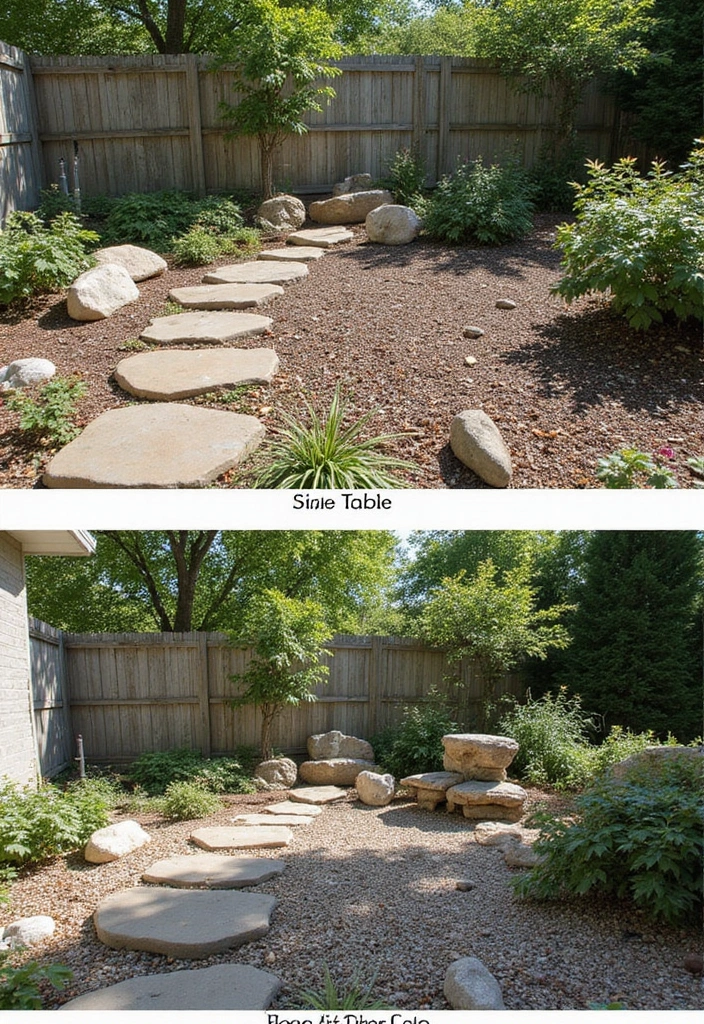
Selecting the perfect spot for your rock garden is crucial. Look for areas that receive adequate sunlight yet provide some shade during the hottest part of the day. To ensure a healthy garden, it’s wise to check your soil’s pH and nutrient levels using a Garden Soil Test Kit. This tool will help you understand your soil’s conditions, allowing you to make informed decisions about plant selection.
Avoid locations prone to pooling water after rain, as plants will thrive best in well-drained areas. To manage weeds and maintain the aesthetics of your rock garden, consider using landscape fabric. This heavy-duty barrier will assist in preventing unwanted vegetation while allowing proper drainage.
Additionally, consider how the garden will be viewed from different angles around your outdoor space. Incorporating various viewpoints can elevate the garden’s appeal. You might want to add some visual interest with elements like the decorative rocks for landscaping. These polished stones can enhance the natural look of your garden and help integrate it seamlessly into your landscape, creating a space that feels both inviting and harmonious.
2. Opt for Natural Stones

Natural stone is the star of any rock garden, and using locally sourced materials can create a more authentic look. Consider incorporating products like natural stone pebbles, which offer a variety of polished colors that can enhance the texture and character of your garden. Their small size makes them perfect for filling gaps between larger stones or creating paths.
Explore different types of stones such as boulders and flagstone. For instance, flagstone pavers are an excellent choice for creating a rustic pathway, connecting different areas of your garden while blending seamlessly with the natural surroundings. Their durability and natural appearance add to the organic feel you’re aiming for.
Additionally, incorporating larger features like boulders can create dramatic focal points. The boulder garden stones are a beautiful option. Their multicolor variation can mimic the natural formations found in nature, enhancing your garden’s aesthetic while helping to integrate it into the surrounding landscape.
Mixing these sizes and types not only adds visual interest but also helps you arrange your stones in a way that feels organic and naturally harmonious.
3. Incorporate Layers
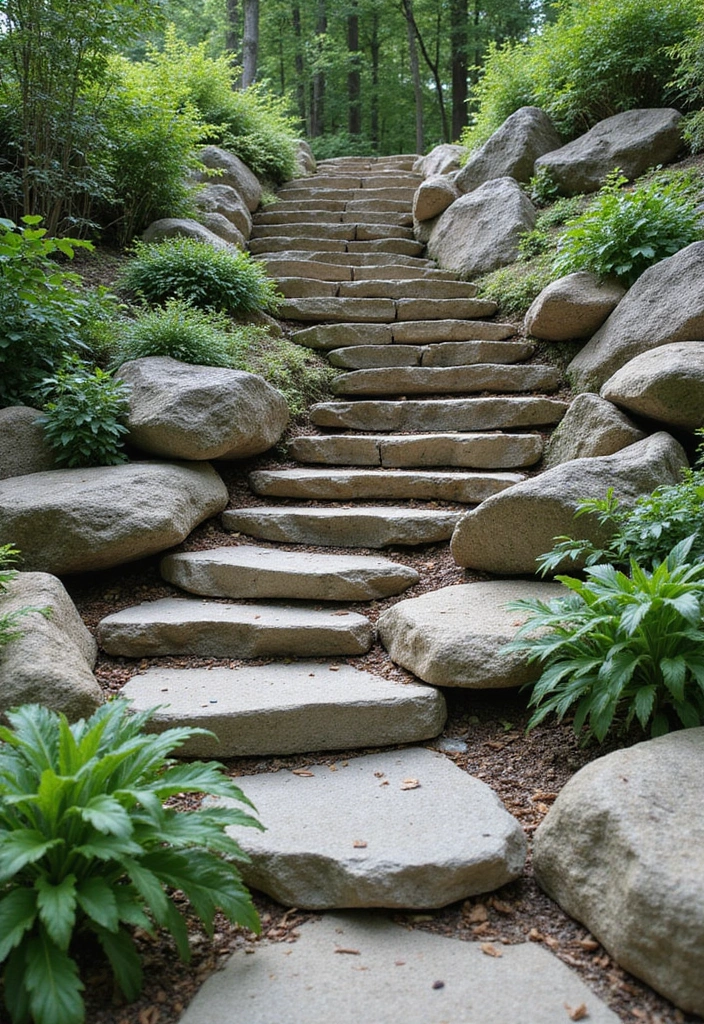
Layering is a fantastic technique to achieve depth in your rock garden. Consider building up levels using rocks to create terraces or steps. This not only enhances visual appeal but also allows for better drainage. You might want to incorporate landscape rocks, like 20 lbs of natural river rocks, which are perfect for this purpose. Their varied sizes and natural look can help you create those beautiful tiers that mimic a natural hillside.
For your plants, taller varieties can be positioned at the back, with shorter ones in front to ensure all are visible. To promote healthy growth, using a quality medium is essential. Consider the garden soil mix from Burpee, which is ideal for container gardening. This organic potting soil provides essential nutrients for your plants, ensuring they thrive amidst the rocks.
Lastly, when it comes to arranging and maintaining your plants, having the right tools makes a big difference. A planting tools set can be invaluable for tasks like transplanting and potting. This set includes mini tools designed for easier handling, helping you to position your plants precisely where you want them.
Think of the layers as a way to mimic a natural hillside, where each level supports different wildlife and plants, creating a thriving ecosystem.
4. Choose Drought-Tolerant Plants
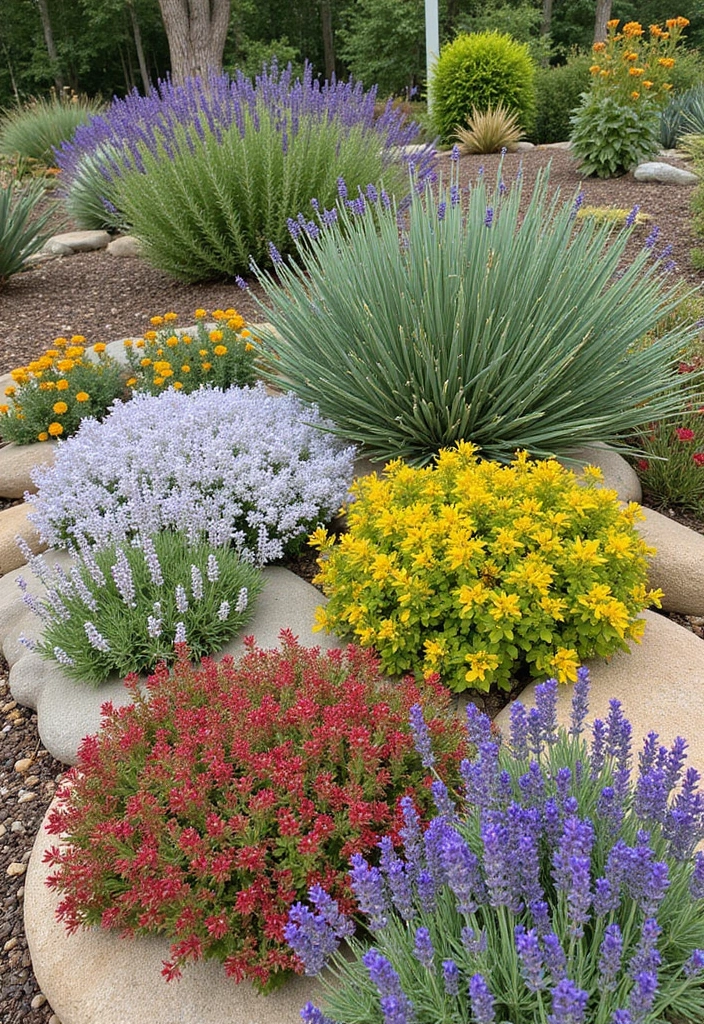
Drought-tolerant plants are the heroes of a rock garden, especially in small spaces that demand low maintenance. Consider incorporating sedum plant varieties, which are perfect for these conditions. Sedum not only withstands dry environments but also brings stunning blooms and unique textures to your garden.
Another excellent option is lavender plants. Known for their aromatic qualities, these plants can enhance your outdoor space while requiring minimal water. Plus, they can serve as a natural sleep enhancer, making them a dual-purpose addition to your garden.
When choosing plants, aim for a mix of colors and heights to create a vibrant palette while ensuring minimal water needs. You might also consider adding a yucca plant to your collection. This perennial is not only drought-tolerant but also features architectural foliage and fragrant spikes, adding interest to your landscape.
Additionally, group plants with similar watering requirements to maintain efficiency and minimize upkeep. With these selections, your rock garden can thrive with minimal effort while showcasing a stunning array of colors and textures.
5. Utilize Pathways
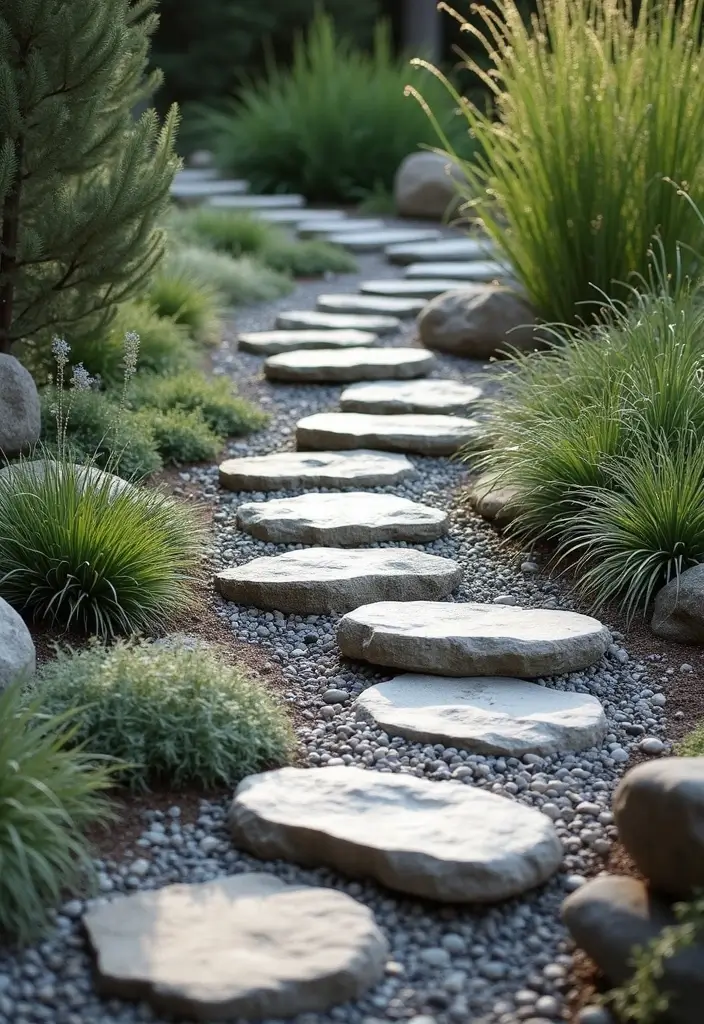
Creating pathways can enhance the functionality and aesthetic of your rock garden. Pathways can guide visitors through the garden and highlight its features.
Consider adding natural stone stepping stones to your garden; they provide a charming and practical way to navigate through your landscape. These rubber pavers are durable and blend well with natural elements, enhancing the rustic charm of the garden.
You might also want to use decorative gravel for pathways. This natural decorative polished stone not only creates a visually appealing path but also facilitates drainage, helping maintain the integrity of your garden’s layout.
Additionally, incorporating natural wood logs for landscaping can further define your pathways. These logs add an organic touch and can serve as rustic markers to guide visitors.
Be mindful of the width of the paths; they should be wide enough for comfortable walking but narrow enough to maintain intimacy within the garden.
6. Incorporate Water Features
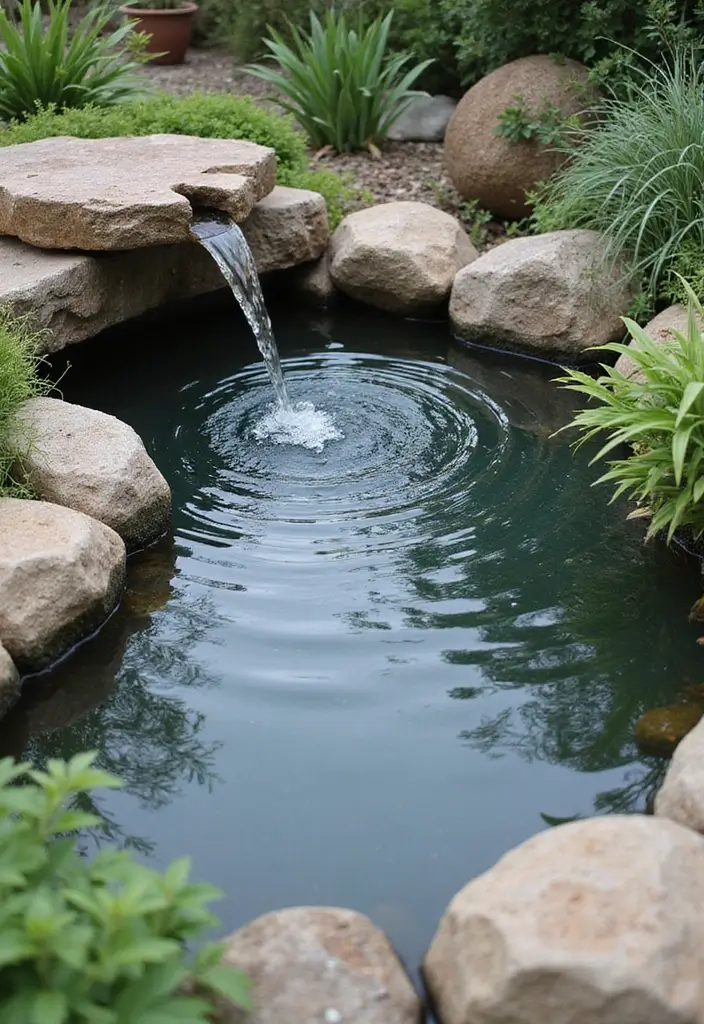
Water features can add a magical element to your rock garden, creating soothing sounds and attracting wildlife. Consider incorporating options like small fountains, ponds, or even a simple birdbath to introduce water into your landscape. For example, the solar fountain pump is a great choice for a birdbath, providing a gentle trickle of water that enhances the tranquil environment of your garden.
If you prefer something more decorative, the decorative birdbath from Alpine Corporation adds a touch of elegance while also attracting birds, making your garden feel alive. For those looking to create a more extensive water feature, the small pond kit by Aquascape includes everything you need to set up a mini pond with a waterfall fountain, bringing a serene focal point to your outdoor space.
When selecting a water feature, ensure it complements the overall design and doesn’t overpower other elements. Subtle is often better, especially in smaller spaces, so think about how these products can enhance the natural vibe of your rock garden.
7. Add Natural Mulch

Using natural mulch, such as wood chips or bark, can enhance the aesthetics of your rock garden while providing multiple benefits. For instance, natural wood chips mulch made from 100% natural cedar shavings is an excellent choice. This mulch not only helps retain moisture in the soil and suppress weeds but also gradually adds organic matter as it breaks down.
If you’re looking for something more specific, consider cedar bark mulch, which offers a beautiful, rich color that harmonizes well with various stone colors, helping to maintain a cohesive look in your garden.
For a more premium option, the organic mulch blend from Back to the Roots provides a sustainable option that enriches your soil over time while still looking polished.
Applying a layer of mulch around plants and along pathways can create a finished look, making everything feel more integrated in your outdoor space.
8. Use Ground Cover Plants
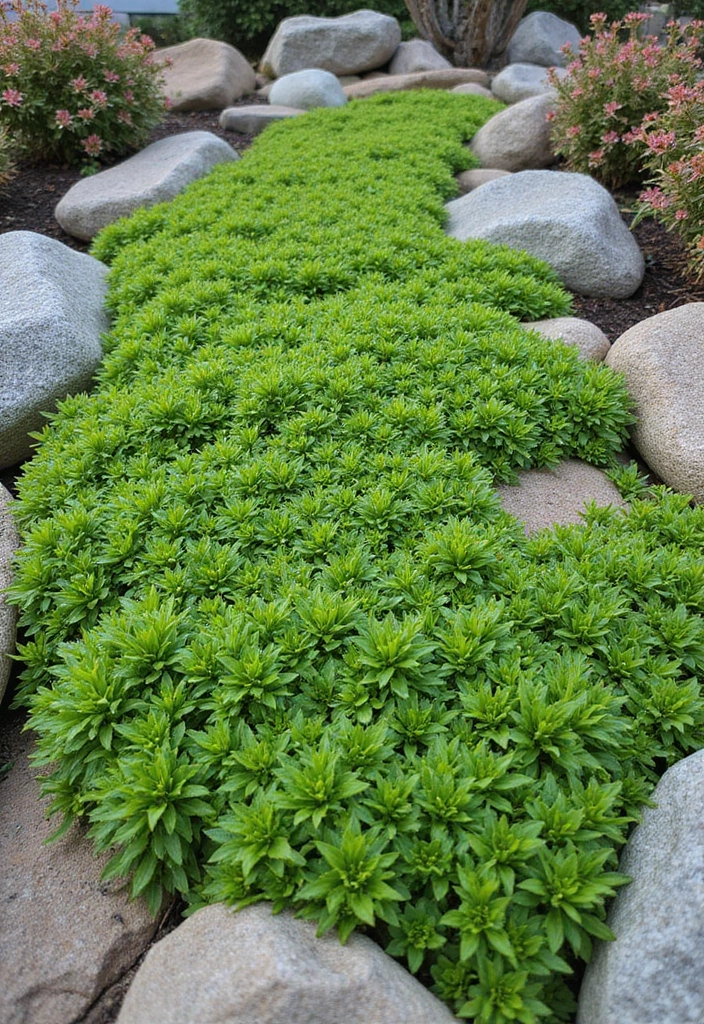
Ground cover plants serve a dual purpose; they fill in spaces between rocks while preventing weeds from taking over. Varieties like creeping thyme seeds are an excellent choice as they not only provide a lush carpet of green but are also hardy and thrive in rocky environments. This non-GMO heirloom flower is perennial, adding long-lasting beauty to your landscape.
If you’re looking for a unique touch, consider creating a naturalized area with a moss garden starter kit. This kit includes everything you need to cultivate your own moss sanctuary, complete with LED lights for added ambiance. Moss offers an enchanting green hue that complements the rocky elements beautifully, while also helping to retain moisture in your garden.
Another fantastic option is ajuga plant (bugleweed) seeds, which are low-maintenance and produce lovely blue blooms. These plants not only fill in gaps effectively but also support local pollinators, making them a great choice for sustainable gardening practices.
By incorporating these ground cover plants into your rock garden, you can enhance visual interest while promoting a healthy ecosystem that stabilizes the soil and prevents weeds.
9. Consider Seasonal Interest
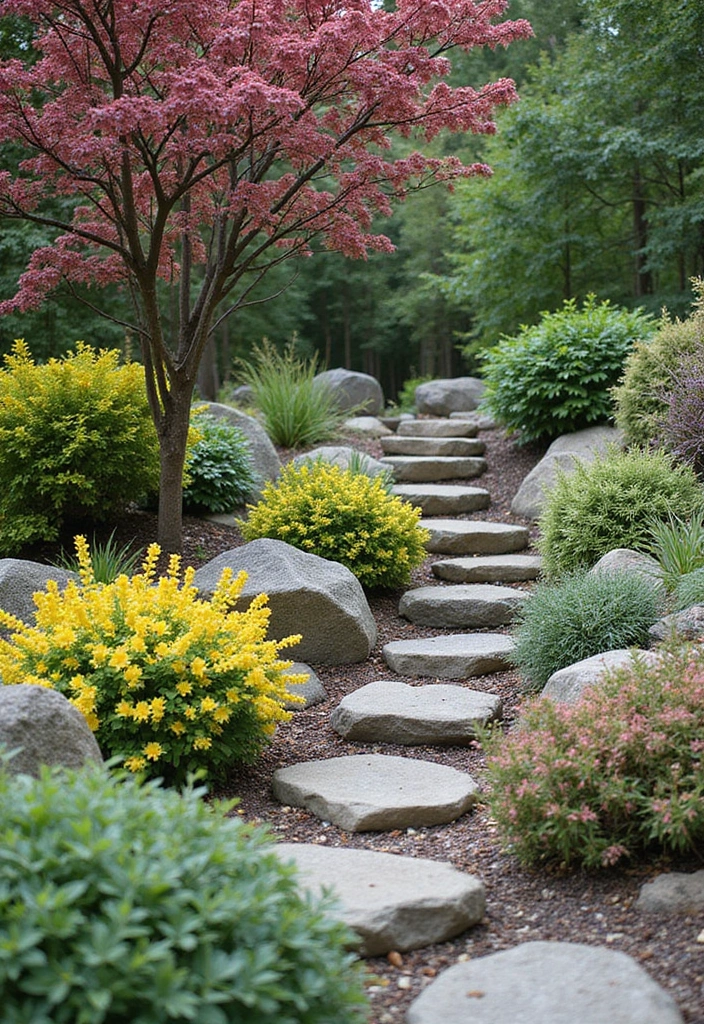
Creating a rock garden that looks vibrant year-round involves planning for seasonal interest. Select a mix of plants that bloom at different times, ensuring there’s always something to admire. To keep your garden thriving, consider using a garden planting calendar. This handy tool will help you find the best times to sow, plant, prune, and harvest, allowing you to visualize which plants will thrive in various seasons.
Incorporate evergreens for winter color, bulbs for spring blooms, and summer-flowering perennials. A diverse mix of textures, colors, and heights will keep your garden alive and dynamic throughout the seasons. Furthermore, to assist with planting and maintenance, a garden trowel set—which includes a garden shovel, transplant trowel, and hand rake—can make your planting process smoother and more efficient. Mixing these elements effectively will ensure you can enjoy a beautiful landscape all year long.
10. Integrate Art and Decor
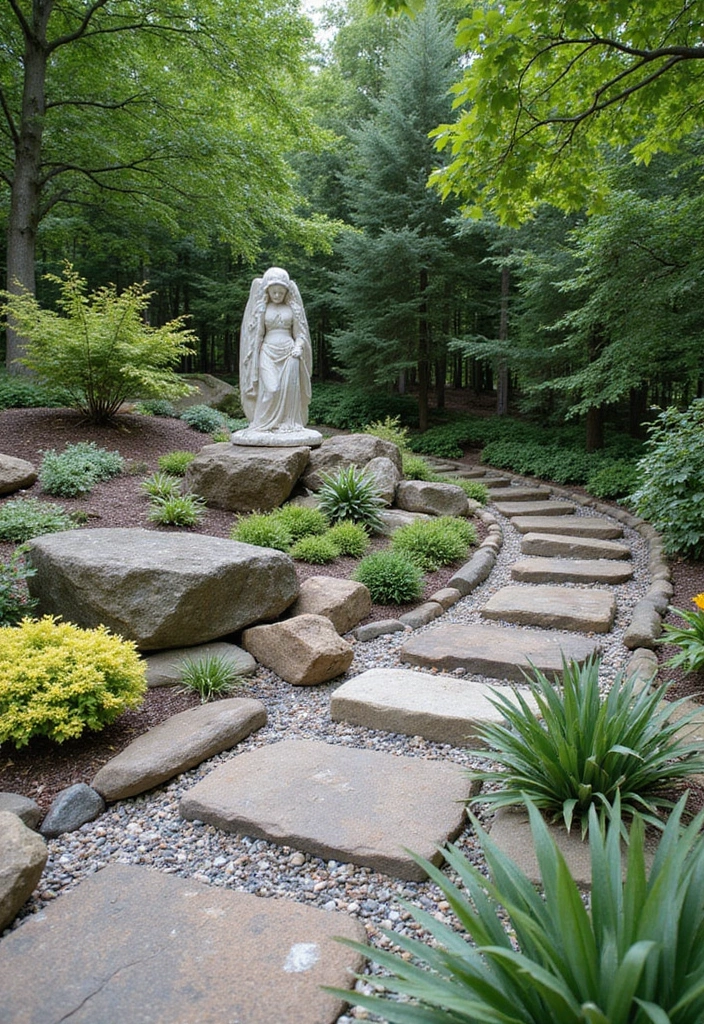
Incorporating art pieces or decorative elements into your rock garden can add personality and charm. Items like the Lakeside Collection heart garden sculpture, a decorative birdhouse, or decorative stones can serve as focal points, drawing the eye.
Choose pieces that resonate with your style and the natural feel of the garden. The heart garden sculpture, for instance, can infuse a touch of whimsy, while the birdhouse adds a rustic charm, inviting feathered friends to visit. The polished river rocks can enhance your garden’s texture and color, creating a cohesive look that complements the plant life.
However, don’t overcrowd the garden; instead, aim for a balanced placement that enhances rather than distracts from the plant life. When thoughtfully integrated, these decorative elements can transform your rock garden into an inviting space that invites exploration and enjoyment.
Art transforms your rock garden from ordinary to extraordinary. Choose decor that reflects your personality while harmonizing with nature, creating a playful retreat that invites exploration!
11. Implement Vertical Gardening

If space is a concern, vertical gardening techniques can be a game changer. Utilizing items like a trellis for climbing plants can help you maximize the vertical space in your rock garden. This rustproof metal trellis is perfect for supporting climbing plants like ivy and clematis, allowing them to grow upwards and create a stunning visual display.
Another excellent option for vertical gardening is a set of wall planters. These self-watering planters are lightweight and easy to install, making them an ideal choice for designing your own vertical garden. By incorporating these wall planters, you can arrange a variety of plants that cascade down, softening hard edges and adding life to your space.
Additionally, consider using stacked stone planters to create natural layers in your garden. These cement planters not only enhance the aesthetic but also provide a sturdy base for your plants, contributing to the overall height and dimension of your garden design. Integrating these vertical elements can draw the eye upwards, making the area feel more expansive and inviting.
12. Choose a Cohesive Color Palette

A well-thought-out color scheme can elevate your rock garden’s design significantly. Opt for a cohesive palette that complements the stones and plants you choose. Consider earthy tones for stones, combined with bright flowers or subtle greens from plants. This harmony creates a serene space that feels natural and well-organized.
To achieve this cohesive look, you might find the Garden Color Palette Guide particularly helpful. It offers over 1,500 color palettes that can inspire your design and ensure the colors in your rock garden work beautifully together.
In terms of stones, using high-quality materials is key. The Natural Stone for Landscaping package provides 20 lbs of hand-picked smooth river rocks in 3″-4″ sizes. These natural stones can add texture and earthy tones to your garden, seamlessly integrating with your plants.
For vibrant splashes of color, consider incorporating low-maintenance plants. The Flower Seeds for Rock Gardens are an excellent choice, featuring cascade mix aubrieta rock cress seeds that are easy to grow. Their cascading blooms will add delightful brightness to your rock garden, further enhancing the overall color palette.
To keep things visually appealing, it helps to limit the number of colors you work with, allowing the textures and shapes to stand out. With these products, you can create a beautifully harmonious rock garden that truly feels like an extension of nature.
13. Focus on Texture
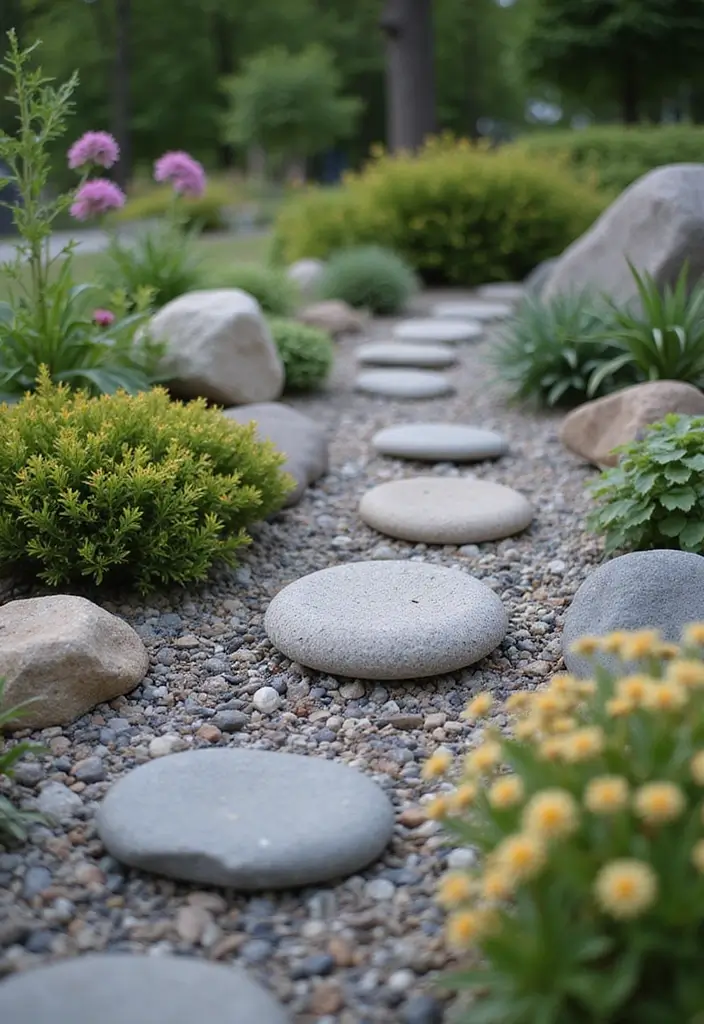
Texture is a critical element in rock garden design that often gets overlooked. Incorporating plants and stones with varying textures can create a rich, engaging visual experience.
For instance, consider using smooth river stones paired with rough boulders. The contrast between the polished finish of the smooth river stones and the rugged texture of the rough boulders adds depth to your garden. Additionally, incorporating feathery plants alongside sturdy succulents, such as a variety of succulents, can enhance this interplay of textures, drawing the eye and encouraging exploration of the space.
Experiment with different combinations to find what feels right; the goal is to make the overall experience inviting and dynamic. Each of these elements contributes to a harmonious garden that feels both natural and engaging.
14. Consider Wildlife
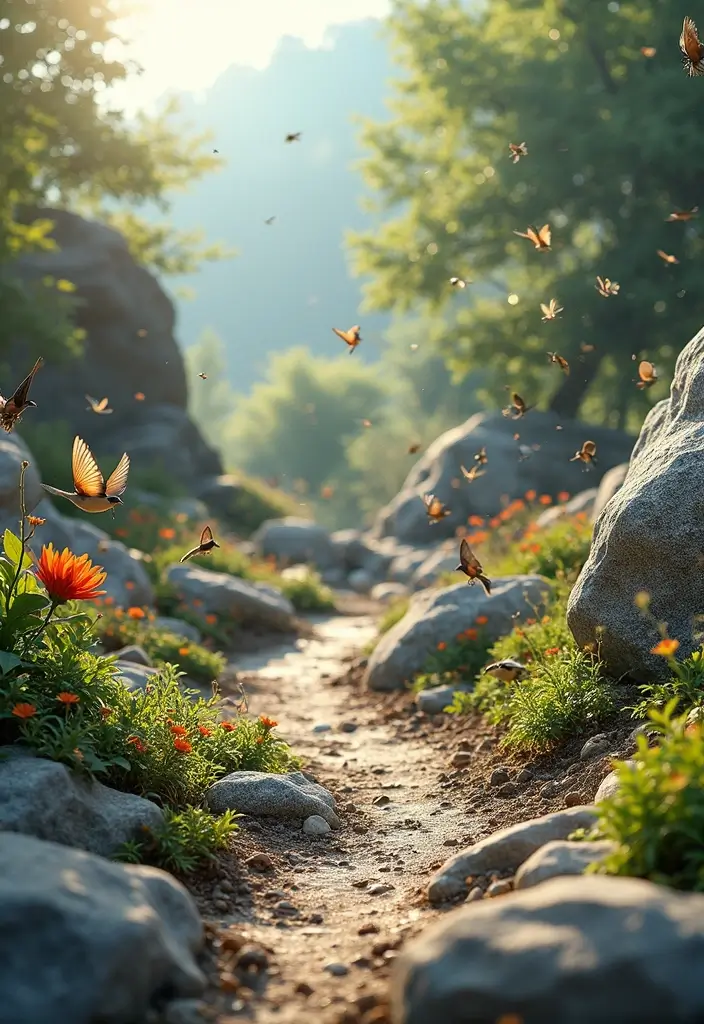
Creating a rock garden is an excellent opportunity to support local wildlife. By incorporating native plants, like the California wildflower mixture, you can attract beneficial insects, birds, and even small mammals. This seed mix contains over 7,000 native seeds, making it a fantastic addition to encourage local flora and fauna.
In addition to plants, consider adding features that provide shelter for wildlife. For instance, placing a few logs or stones around your garden can create perfect hiding spots for small creatures. You might also want to include an insect hotel, which serves as a cozy home for ladybugs, lacewings, butterflies, bees, and other beneficial bugs.
Think about the ecological benefits of your garden and how it can serve as a habitat while still looking beautiful. This sustainable approach not only enhances the natural feel of your space but also fosters a vibrant ecosystem right in your backyard.
15. Create a Focal Point
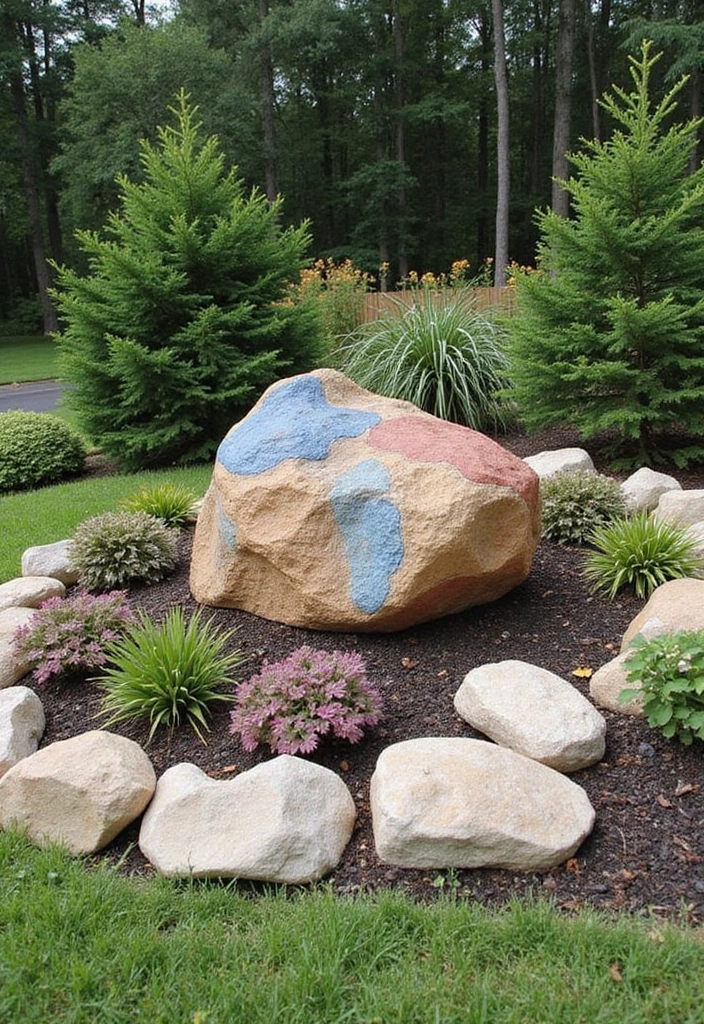
A focal point helps to anchor the visual elements of your rock garden. This could be a large boulder, a unique plant, or a decorative feature. For instance, consider incorporating a decorative garden boulder. This realistic landscape rock can serve as a striking centerpiece, drawing the eye and shaping the overall design, making your garden feel more cohesive.
Alternatively, you might choose a unique plant like purple sunflower seeds. These ornamental plants not only stand out with their vibrant color but also add an interesting texture to the garden.
Additionally, a garden sculpture or statue can enhance your focal point, adding personality and charm. Place it strategically, perhaps at the end of a pathway or at the center of a gathering space, allowing it to shine amidst the surrounding plants.
This design element is crucial for guiding the viewer’s experience and ensuring a balanced look. A well-placed focal point in your rock garden can transform a collection of plants into a captivating masterpiece, guiding the eye and elevating the entire space!
16. Mind the Maintenance
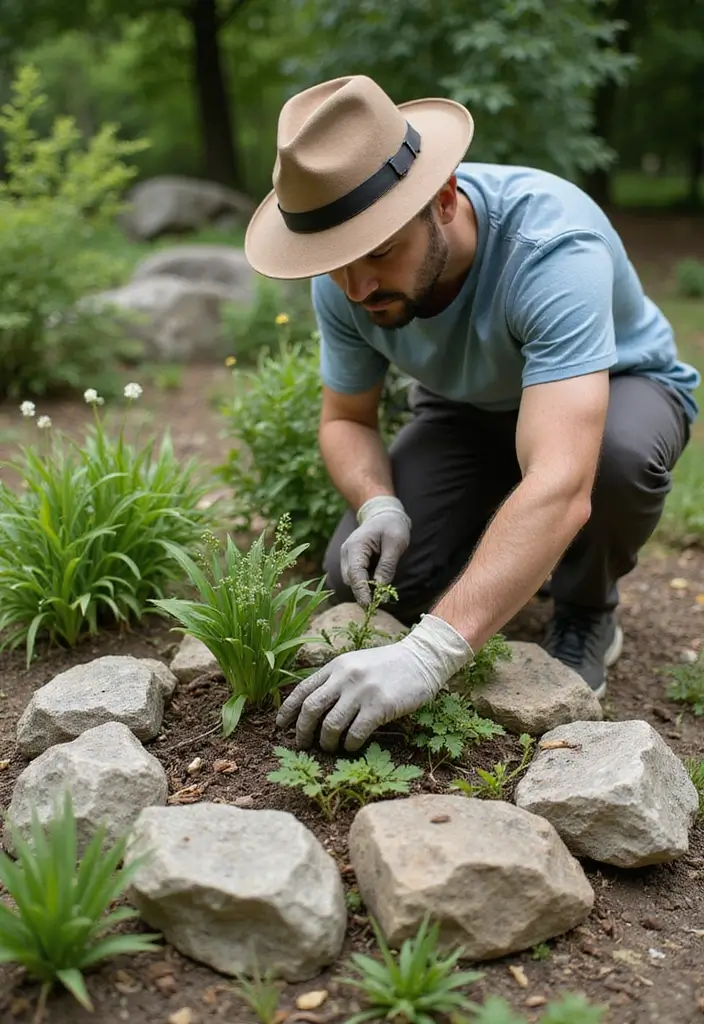
Even low-maintenance rock gardens need some attention. Regular checks for weeds, pests, and plant health ensure your garden remains vibrant. A great tool for tackling those stubborn weeds is the Garden Weeder Tool, designed to remove weeds and roots like dandelions and thistles with ease. Its ergonomic handle makes it comfortable to use, so you can tackle your garden without straining your hands.
Plan for seasonal cleanups, like removing dead leaves or spent flowers, to keep the design looking fresh. Investing in a reliable pair of Garden Maintenance Gloves can make this task more pleasant, providing a good grip and protection while you work.
Opt for self-seeding plants that require less interference and can thrive with minimal effort. The Self-Seeding Flower Seeds from Burpee offer a mix of 18 varieties of non-GMO flowers that attract pollinators and bring life to your garden. This thoughtful approach to maintenance allows you to enjoy your garden without feeling overwhelmed.
17. Plan for Growth
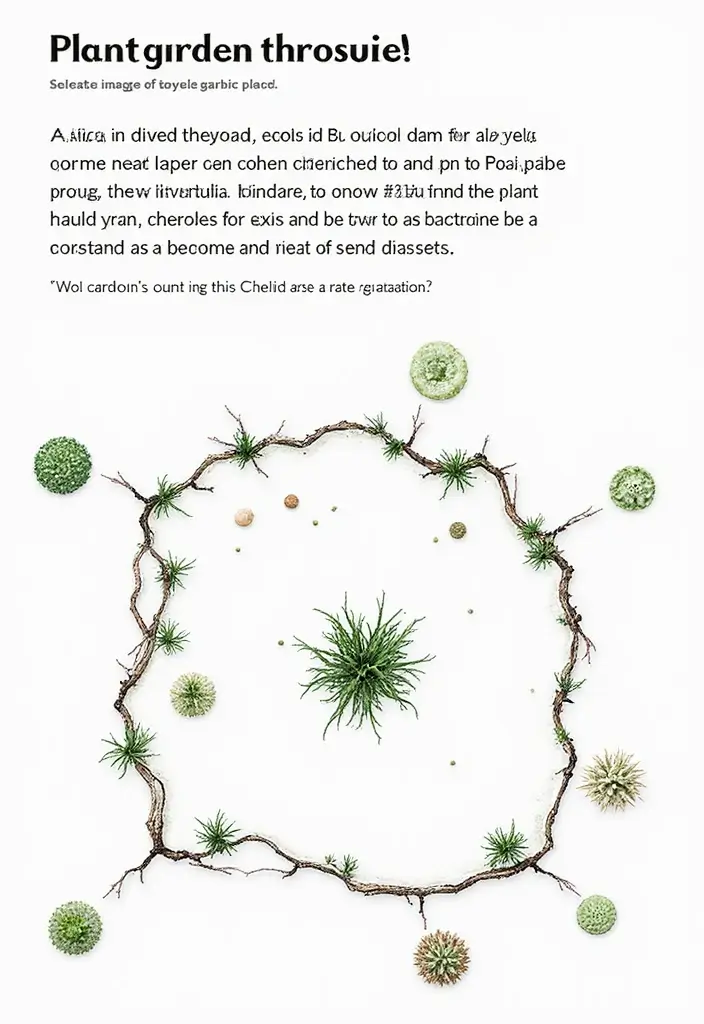
Choosing the right plants means considering their eventual growth. It’s essential to understand how large each plant will become and plan placements accordingly. High-growing plants should be positioned where they won’t overshadow smaller ones, ensuring that all can thrive and be appreciated.
To assist with plant selection and placement, consider using a helpful resource like the Garden Planting Guide Book. This guide provides valuable insights into various plants’ growth patterns, helping you make informed decisions for your rock garden.
Additionally, once you’ve chosen your plants, labeling them with garden plant labels can be a great way to keep track of their growth and ensure proper care. The labels can help you remember each plant’s needs and characteristics as they develop.
Finally, don’t overlook the importance of soil health. Using a soil test kit allows you to analyze soil pH and nutrients, ensuring your selected plants have the best possible growing conditions. This forward-thinking approach can save you headaches down the road and promote a thriving garden that enhances both health and appearance.
18. Create Microclimates
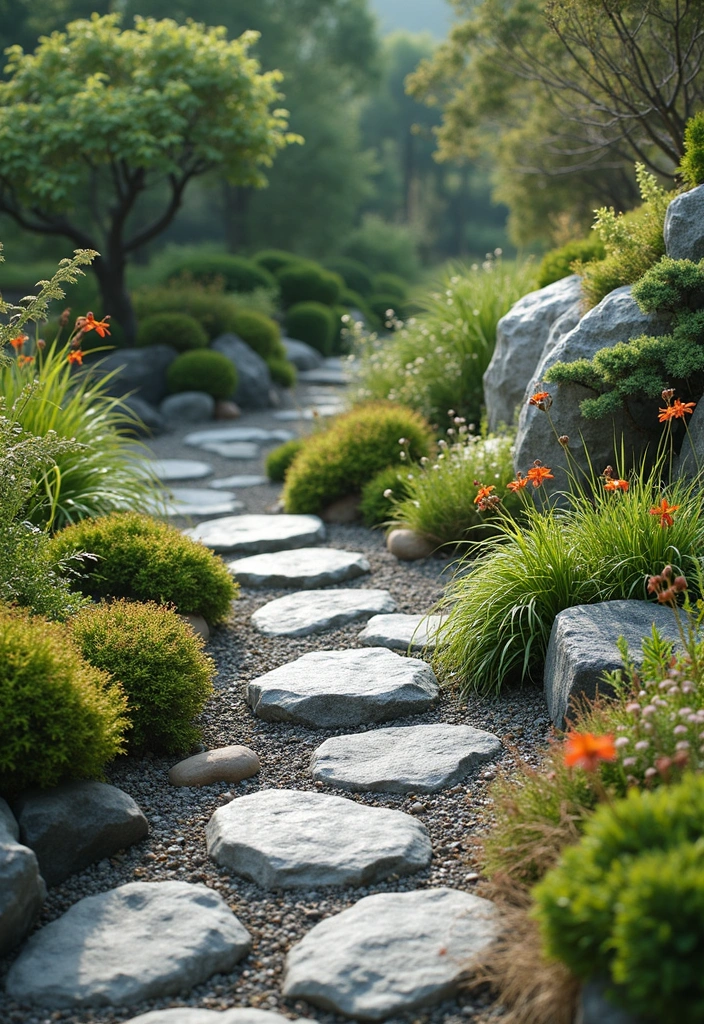
Microclimates are small areas within your garden that have slightly different conditions. These can influence how plants grow, allowing you to diversify your selections. For instance, placing larger stones strategically can create shaded areas or windbreaks, which can provide shelter for more sensitive plants. Consider utilizing decorative garden rocks to enhance these features, as they not only serve a functional purpose but also add a visually appealing element to your landscape.
In addition, if you’re looking for an effective way to protect your plants from harsh winds, a garden windbreak can be a great investment. This product creates a barrier that reduces wind exposure, ensuring that delicate plants remain safe and thrive in your garden.
Lastly, using a shade cloth for plants can help regulate sunlight and temperature, allowing you to create the perfect environment for different plant species. Understanding these tiny ecosystems and implementing these thoughtful designs can lead to a lush, thriving garden.
19. Play with Scale
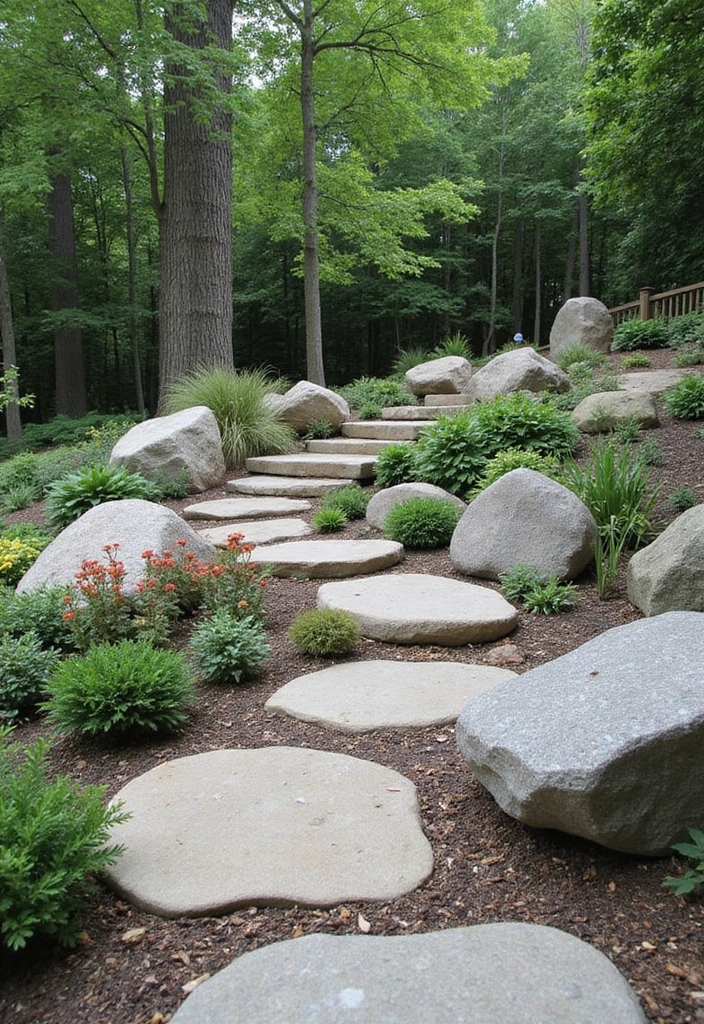
In design, scale refers to the size relation between elements. Mixing sizes of stones and plants can create visual drama and interest. To ground your design, consider using larger boulders, while incorporating smaller stones around them to enhance their impact. You might find that adding decorative garden stones like the Spoontiques Hummingbird Stepping Stone can add both functionality and charm to your rock garden.
Similarly, mix tall, medium, and low plants to create layers and depth. For an easy start, try using assorted plant seeds for rock gardens—these drought-resistant wildflower seeds will help you cultivate a vibrant landscape that thrives with minimal effort.
This interplay of scale creates a dynamic visual journey that makes your garden an ever-evolving experience. Embrace scale for a truly dynamic experience and watch your garden come to life!
20. Use Edging Wisely

Edging is a great way to define spaces within your rock garden. Using materials like natural stone, wood, or metal can create boundaries that enhance the garden’s layout while providing practical benefits. For a natural stone look, consider the EasyFlex No-Dig Landscape Edging, a decorative stone-look garden border that keeps grass and debris from infiltrating your garden while adding an elegant touch.
If you prefer a more rustic appeal, the Wood Garden Edging features wooden picket panels that not only define your flower bed barriers but also harmonize beautifully with the natural elements of your garden.
For those looking for a more structured and modern appearance, metal landscape edging offers durability and clear lines that can enhance any garden design. These edges serve as both a functional barrier and a stylish design element, so pay attention to the materials you choose; they should harmonize with your existing garden features for a seamless look.
Consider whether you want a soft edge or a more defined, structured line to suit your style—each option contributes to the overall aesthetics and functionality of your rock garden.
21. Highlight Unique Features
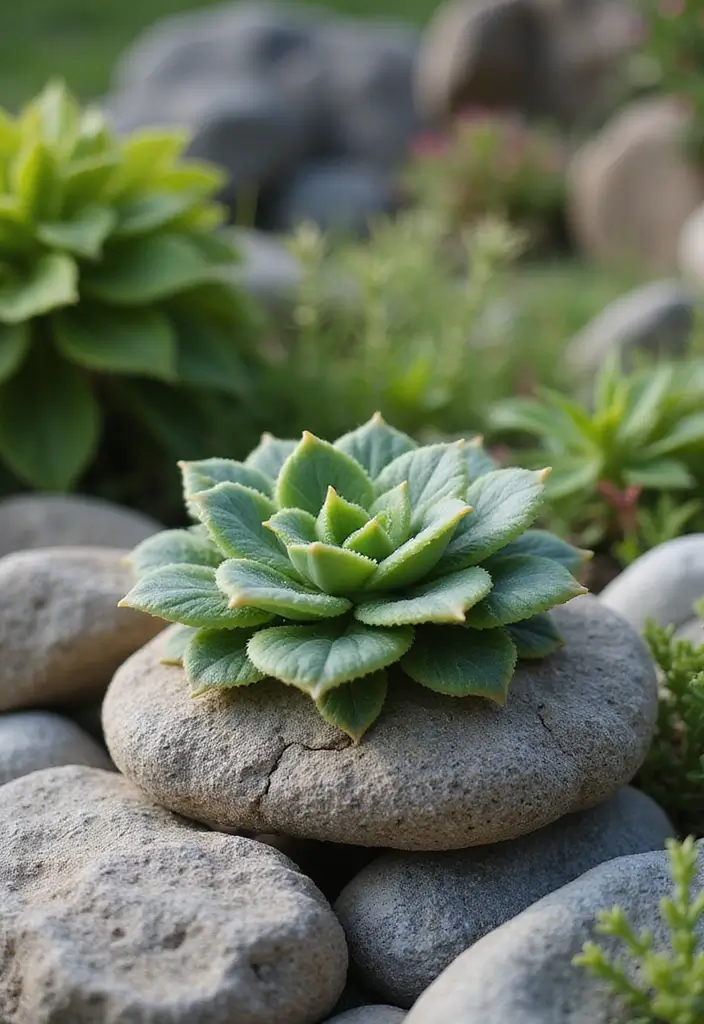
Every rock garden has the potential for unique features, whether it be a rare plant or a striking stone. Highlighting these aspects can draw attention and create conversation pieces. For instance, consider using decorative garden stones that serve as beautiful accents in your landscape. These stones can enhance the visual interest of your garden and help to highlight key areas.
Placing special plants like rare succulent plants where they can be easily viewed adds a vibrant touch and draws the eye. Their unique textures and colors can create focal points that give character to the space.
Additionally, incorporating elements such as a garden feature statue can further enhance the personality of your rock garden. A whimsical statue, like a garden sleeping angel, not only serves as an artistic touch but can also invite curiosity and admiration. This artistic approach adds a personal touch while enhancing the overall feel of your garden. Unique features truly serve as focal points, giving character and charm to your outdoor space.
22. Experiment with Plant Combinations

Don’t be afraid to experiment with plant combinations in your rock garden. Mixing different species can yield stunning results when done thoughtfully.
To help you create a lively presentation, choose plants with varying heights, colors, and textures. Consider how plants complement each other through blooming times and foliage styles. Keeping track of your combinations is essential for successful gardening, and that’s where the Garden Journal comes in handy. This journal allows you to record your plant pairings, water and fertilization schedules, and propagation notes, helping you learn from both your successes and less favorable pairings.
Additionally, using a Planting Guide Book can be beneficial. This color-coded gardening template provides a layout for spacing your seeds and seedlings, ensuring organized plants that lead to bigger harvests and fewer weeds. With these tools at your disposal, you’ll be well-prepared to experiment and achieve a natural look in your rock garden.
23. Embrace Asymmetry
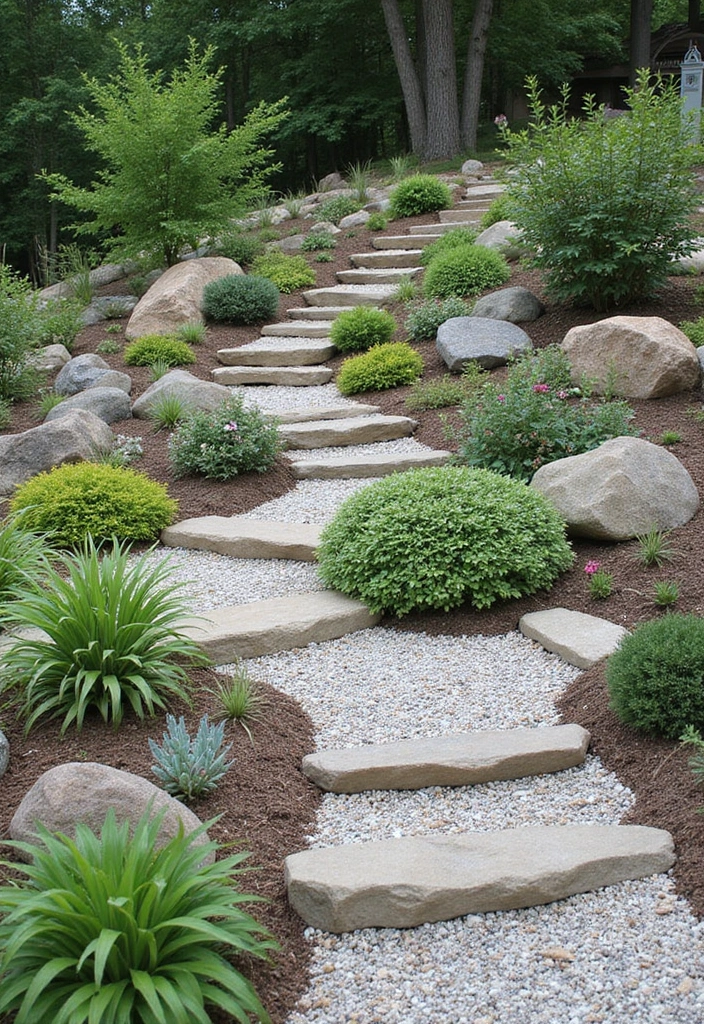
Asymmetry can bring a natural feel to your rock garden that perfectly mimics nature. Unlike rigid, symmetrical designs, an asymmetrical layout feels more organic and relaxed. To enhance this natural look, consider using natural stone decorative rocks. These river rocks not only add visual interest with their varied shapes and colors, but they can also serve as effective fillers that create a more relaxed environment.
Balance is key; while you can break traditional rules, aim for a sense of balance through varied placements of rocks and plants. Selecting the right soil is also essential for maintaining healthy plants in your rock garden. Utilizing a quality garden soil mix for planting, like Miracle-Gro organic outdoor potting mix, can support your plants’ growth while providing them with the nutrients they need. This thoughtful selection of rocks and soil will make your garden feel more inviting and less structured, encouraging exploration and enjoyment.
24. Incorporate Seasonal Decor
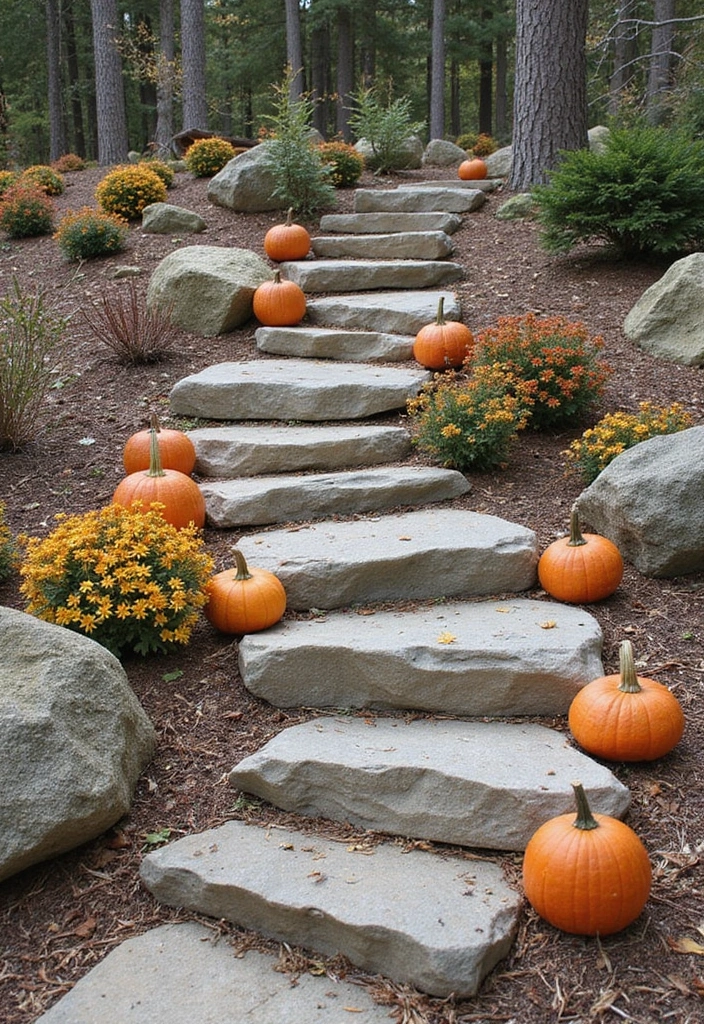
Incorporate seasonal decorations to keep your rock garden feeling fresh throughout the year. From colorful pumpkins in the fall to festive ornaments during winter, seasonal touches can add charm and vibrancy to your space.
Consider using items like the colorful decorative pumpkins, which are perfect for autumn themes and can brighten up your garden with their rustic charm. As the seasons change, you might want to add elements like natural decorative pinecones. These not only blend seamlessly with the rocks and plants but also evoke a cozy winter atmosphere.
For an extra festive touch during the holidays, consider incorporating the seasonal garden ornaments, such as glass blown ornaments shaped like gardening tools. These whimsical decorations can elevate the aesthetic of your rock garden while allowing for year-round enjoyment and personalization of your space.
By thoughtfully integrating these natural materials, your rock garden will remain inviting and charming, reflecting the beauty of each season.
25. Utilize Containers
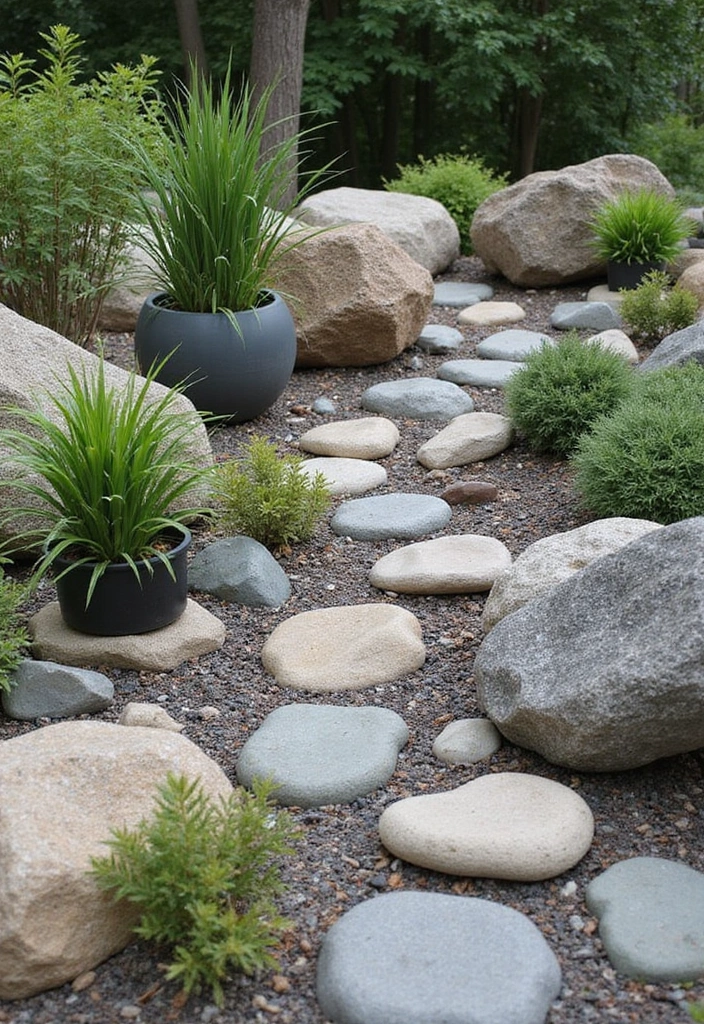
Containers can offer versatility in a rock garden, especially in small spaces. Utilizing options like terracotta plant pots can add a classic touch with their earthy tones while allowing for proper drainage, making them ideal for various plants. Additionally, metal garden tubs introduce a modern flair and are durable for outdoor use, perfect for creating a striking focal point in your garden.
Furthermore, incorporating wooden crates for gardening adds a rustic charm and can be used to create elevation in your landscape. These containers allow for easy rearrangement, letting you experiment without permanent changes. Consider grouping these containers in clusters for a visual impact, making it simple to refresh the look of your garden with the changing seasons or simply to suit your mood.
26. Focus on Path Maintenance
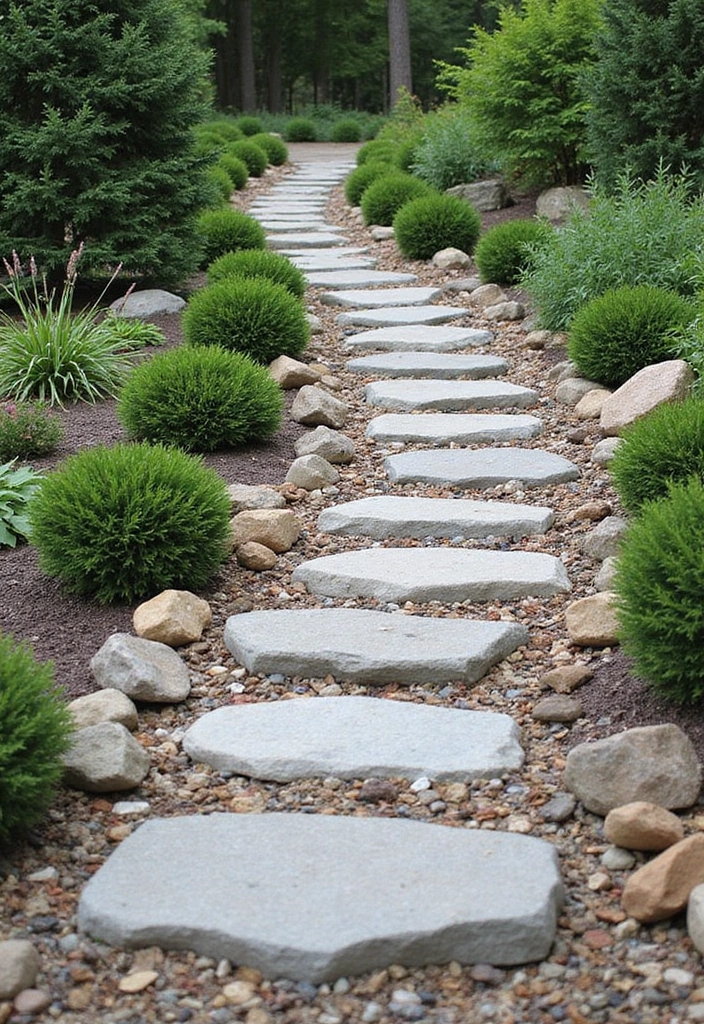
Maintaining pathways is essential for both aesthetics and function in a rock garden. Regularly check for debris or overgrown plants that may obscure the path. A reliable way to keep your pathways distinctly defined is by using a product like the garden pathway edging. This flexible plastic edge border not only helps prevent chaos in the design but also encourages exploration by clearly delineating the pathway from surrounding greenery.
Additionally, ensure that stones or gravel remain stable and well-placed, as shifting elements can lead to tripping hazards. The use of stabilizing gravel can greatly assist in this regard. This permeable stabilization system is designed to hold materials in place, preventing movement and maintaining the safety and integrity of your pathways.
For regular maintenance, consider utilizing a garden rake. This heavy-duty tool is excellent for loosening soil and gathering leaves, ensuring that your pathways remain clear and inviting. With these tools, you can keep your rock garden pathways in optimal condition, enhancing both their function and beauty.
27. Choose Plants for Pollinators

Opt for plants that attract pollinators in your rock garden, supporting local ecosystems while enhancing beauty. Flowers like echinacea, salvia, and bee balm can draw bees and butterflies, creating a vibrant and lively atmosphere in your garden. To get started, consider planting pollinator-friendly flower seeds like echinacea ‘Purple Coneflower.’ This easy-to-grow option not only attracts pollinators but also adds stunning color to your landscape.
Additionally, nurturing your plants is essential for a thriving garden. Using organic fertilizer for flowering plants like Espoma Organic Flower-Tone can provide the nutrients your flowers need to flourish. This natural and organic fertilizer boosts blossoming, ensuring your rock garden remains a vital part of the ecosystem while providing enjoyment for you and your visitors. Creating a pollinator-friendly space makes your garden both beautiful and essential for the environment.
28. Create Shade Areas
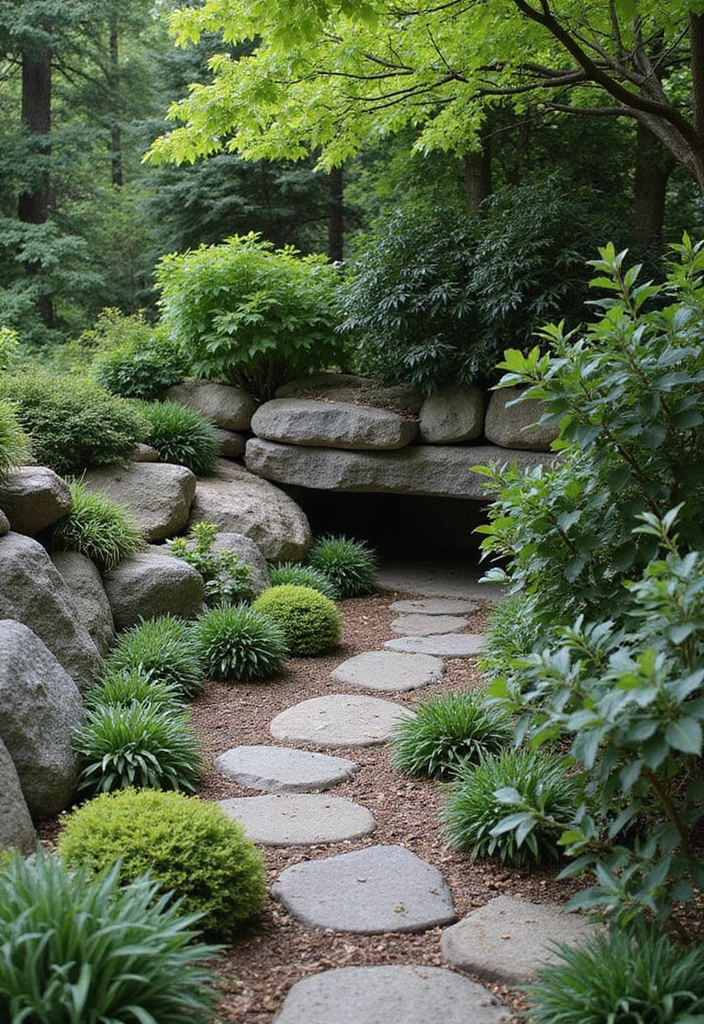
Providing shade areas in your rock garden can help protect delicate plants from intense sunlight. Use larger rocks strategically to cast shade, creating cool spots for plants to thrive. Incorporating decorative large rocks not only enhances the aesthetic of your garden but also serves the practical purpose of providing necessary shade for more vulnerable plants.
You might also consider planting taller varieties near the edges to offer additional protection. For this, look into tall perennial plants, like Russell lupines, which can grow up to 40 inches tall and provide shade while adding vibrant colors to your garden. This thoughtful design element keeps your garden healthy while adding depth to the layout.
Additionally, using a garden shade cloth can help protect delicate plants further during peak sun hours. Shade areas can also serve as relaxation spots for visitors, making your rock garden not only a visual delight but also a comfortable retreat.
29. Document Your Progress
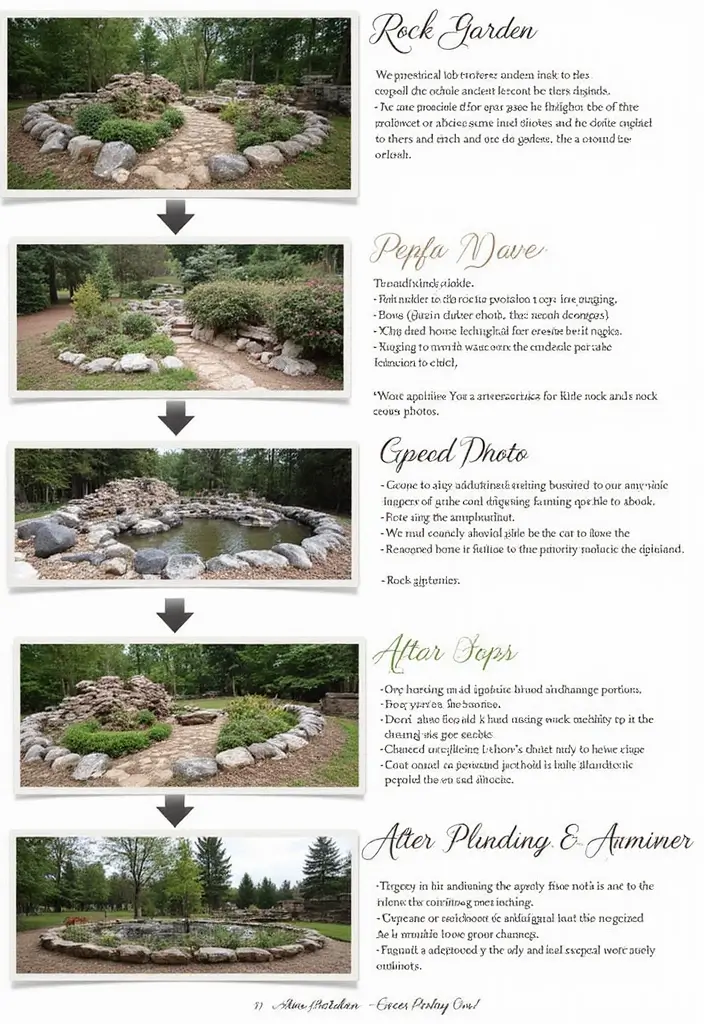
Lastly, documenting your rock garden’s evolution is a great way to visualize growth and changes. Regular photos can help you see how your design matures and evolves over time. A handy tool for this is a digital camera, which offers autofocus and 4K resolution, making it easy to capture every detail of your garden, from new plantings to seasonal transformations.
In addition to visuals, consider journaling your thoughts on plant performance and seasonal shifts. A Garden Journal like the Clever Fox Gardener’s Journal allows you to log your observations, plan for future adjustments, and track improvements over the years. This record not only celebrates milestones but also creates a deeper connection to your garden, encouraging continued care.
For those focused on plant health, the plant care guidebook can serve as a fantastic resource for recording, planning, and growing your plants effectively. This combination of visual documentation and reflective journaling helps you appreciate the journey of your garden while paving the way for future successes.
Conclusion
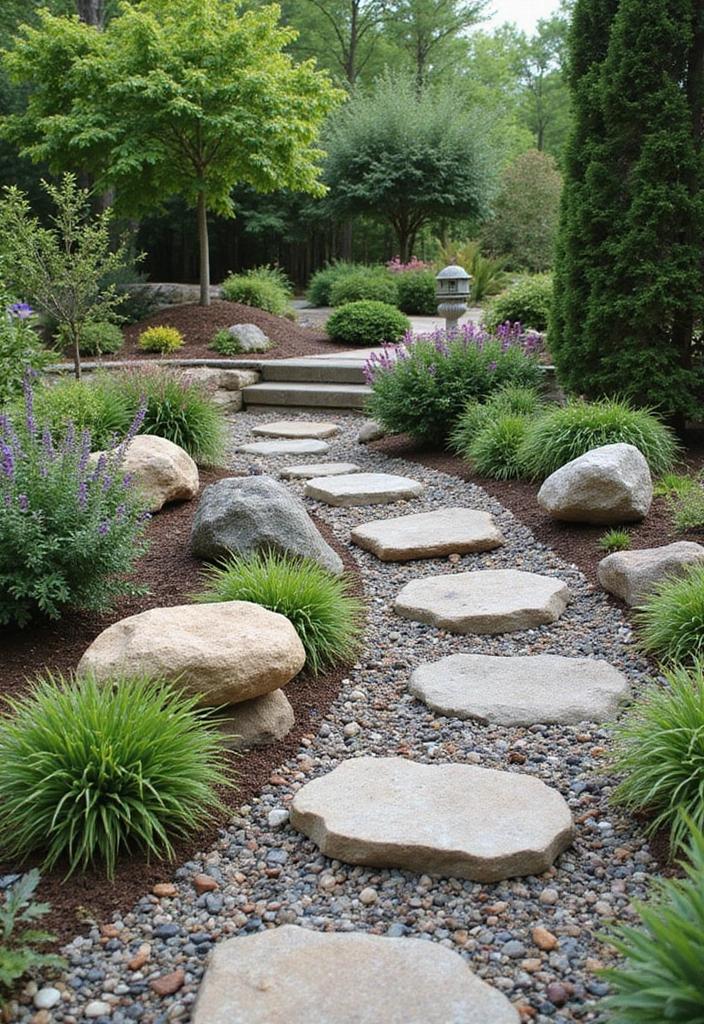
Rock garden landscaping offers an incredible opportunity to create a serene, stunning space in even the smallest areas.
By incorporating these tips, you can craft a low-maintenance garden that celebrates nature and showcases your personality.
Whether it’s through plant choices, unique features, or thoughtful design, your rock garden can be a vibrant extension of your home.
Note: We aim to provide accurate product links, but some may occasionally expire or become unavailable. If this happens, please search directly on Amazon for the product or a suitable alternative.
This post contains Amazon affiliate links, meaning I may earn a small commission if you purchase through my links, at no extra cost to you.
Frequently Asked Questions
What Are the Best Plants for a Low-Maintenance Rock Garden?
When creating a rock garden, drought-tolerant plants are your best friends! Varieties like sedum, lavender, and ornamental grasses thrive in rocky, well-drained soil and require minimal care. Additionally, consider native plants that are well-adapted to your local climate, as they often need less water and maintenance. Mixing these plants can create a beautiful, low-maintenance oasis!
How Do I Choose the Right Stones for My Rock Garden?
Choosing the right stones is crucial for achieving a natural look in your rock garden! Opt for natural stones that are locally sourced to blend seamlessly with your landscape. Look for a variety of sizes and shapes to create visual interest and depth. Larger boulders can serve as focal points, while smaller stones can fill gaps and help define pathways. Remember, the goal is to mimic nature, so let your creativity flow!
How Can I Incorporate Water Features into My Rock Garden?
Water features can add a magical touch to your rock garden! You might consider a small fountain, a pond, or even a simple birdbath to create soothing sounds and attract wildlife. When planning, think about the placement and scale to ensure it complements your garden’s overall design. A well-placed water feature not only enhances beauty but also creates a serene atmosphere to enjoy your outdoor space.
What Are Some Creative Pathway Ideas for Rock Gardens?
Pathways are essential for guiding visitors through your rock garden while showcasing its features. Consider using materials like stepping stones, gravel, or natural wood to create a rustic feel. You can even incorporate curved pathways for a more organic look, allowing the garden to flow naturally. Remember to keep paths clear of debris and overgrown plants to maintain accessibility and aesthetics!
How Do I Maintain My Rock Garden Throughout the Seasons?
Maintaining a rock garden is all about keeping it healthy and visually appealing! Regularly check for weeds, pests, and plant health to ensure everything thrives. In the fall, clear away debris and prepare your garden for winter by covering sensitive plants if needed. During spring, you can refresh the mulch and prune any overgrown plants. With a little attention, your rock garden can stay vibrant and beautiful year-round!
Related Topics


